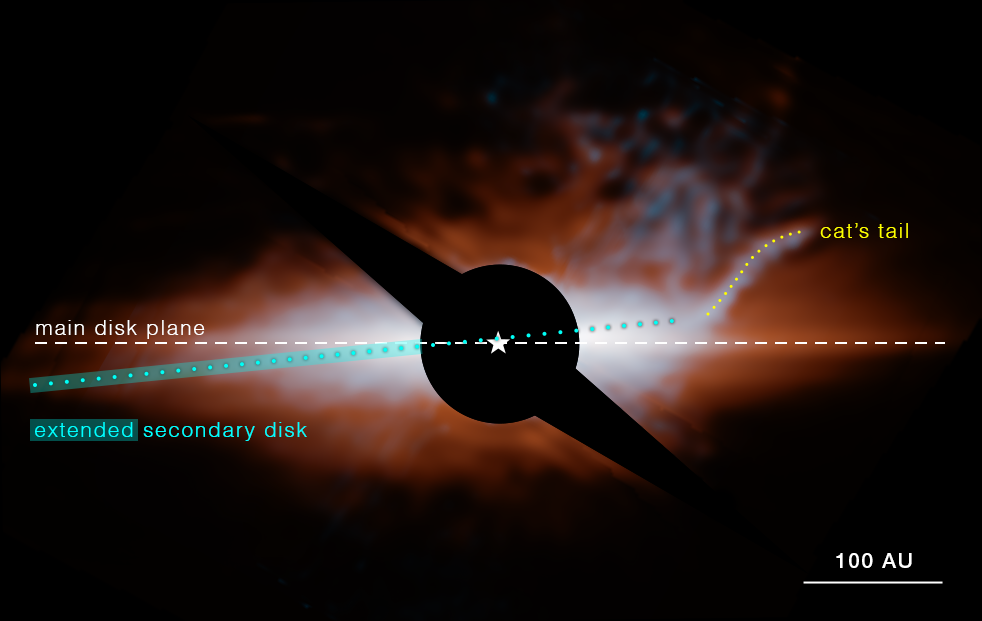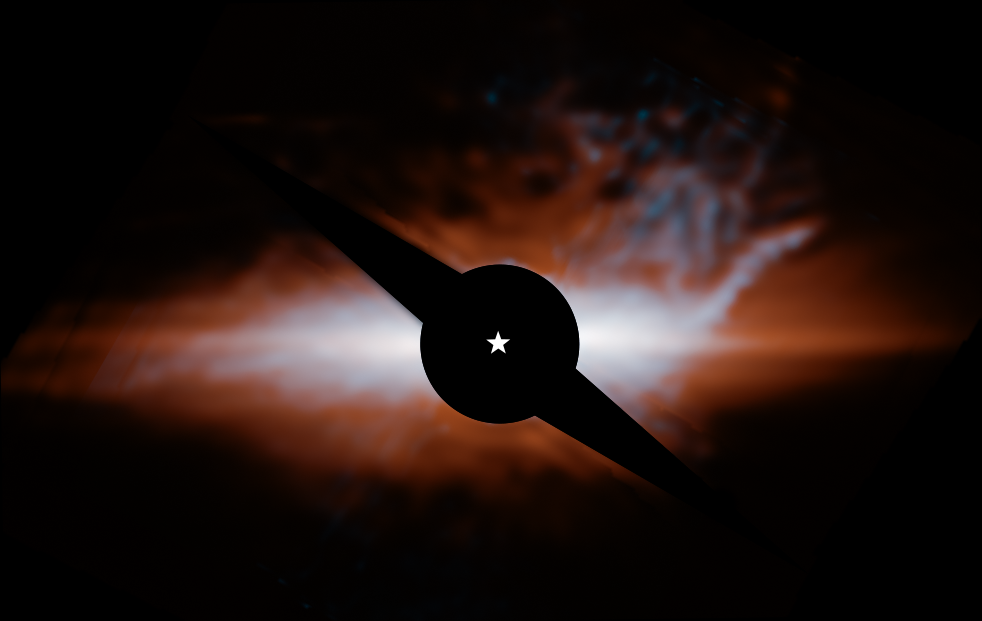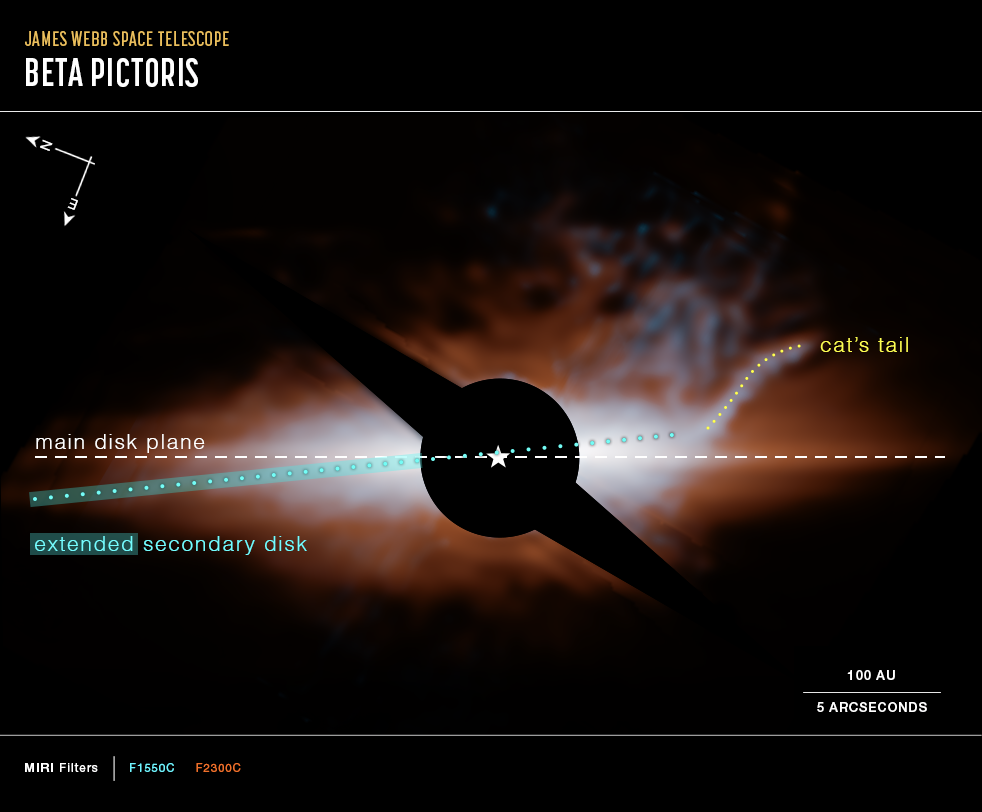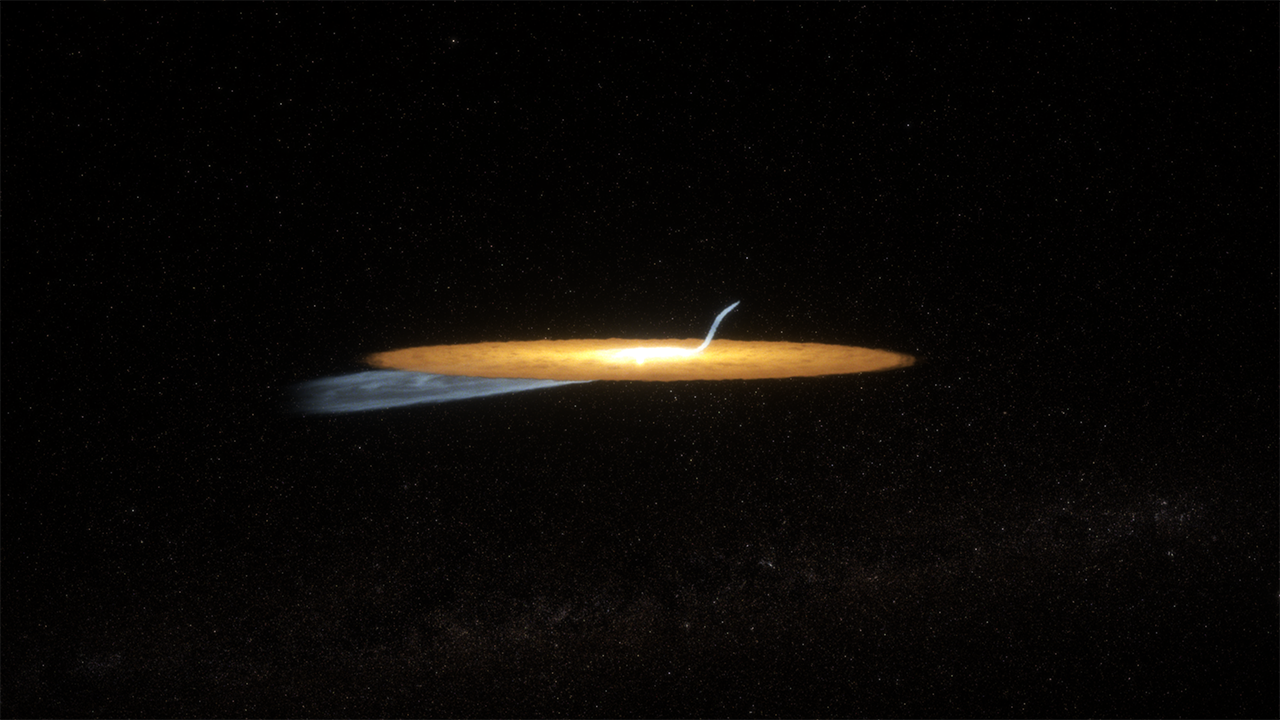1 min read
Beta Pictoris (MIRI Annotated Image)

Annotated version of the Beta Pictoris image captured by Webb’s MIRI (Mid-Infrared Instrument). A coronagraph (black circle and two small disks) has been used to block the light of the central star. Certain features are highlighted and labeled.
A white line traces over the orange main debris disk and is labeled “main disk plane.” A thin blue-green disk is inclined about five degrees counterclockwise relative to the orange main disk and is highlighted by a blue-green line labeled “extended secondary disk.” Some of the gray material clustered near the center forms a curved feature in the upper right, which is marked with a yellow line labeled “cat’s tail.”
A scale bar shows that the disks of Beta Pic extend for hundreds of astronomical units (AU), where one AU is the average Earth-Sun distance. (In our solar system, Neptune orbits 30 AU from the sun.) In this image, light at 15.5 microns is colored cyan and 23 microns is orange (filters F1550C and F2300C, respectively).
About the Object
- R.A. PositionR.A. PositionRight ascension – analogous to longitude – is one component of an object's position.05:47:17.08
- Dec. PositionDec. PositionDeclination – analogous to latitude – is one component of an object's position.-51:03:59.43
- ConstellationConstellationOne of 88 recognized regions of the celestial sphere in which the object appears.Pictor
- DistanceDistanceThe physical distance from Earth to the astronomical object. Distances within our solar system are usually measured in Astronomical Units (AU). Distances between stars are usually measured in light-years. Interstellar distances can also be measured in parsecs.63 light-years (19 parsecs)
- DimensionsDimensionsThe physical size of the object or the apparent angle it subtends on the sky.Image is about 3.6 arcseconds across (712 au)
About the Data
- Data DescriptionData DescriptionProposal: A description of the observations, their scientific justification, and the links to the data available in the science archive.
Science Team: The astronomers who planned the observations and analyzed the data. "PI" refers to the Principal Investigator.This image was created with Hubble data from proposal: 1411 (C. Stark). Image Processing: Alyssa Pagan (STScI).
- InstrumentInstrumentThe science instrument used to produce the data.MIRI
- Exposure DatesExposure DatesThe date(s) that the telescope made its observations and the total exposure time.13 December 2022
- FiltersFiltersThe camera filters that were used in the science observations.F1550C, F2300C
- Object NameObject NameA name or catalog number that astronomers use to identify an astronomical object.Beta Pictoris
- Object DescriptionObject DescriptionThe type of astronomical object.Debris disk
- Release DateJanuary 10, 2024
- Science ReleaseNASA’s Webb Discovers Dusty ‘Cat’s Tail’ in Beta Pictoris System
- CreditImage: NASA, ESA, CSA, STScI, Christopher Stark (NASA-GSFC), Kellen Lawson (NASA-GSFC), Jens Kammerer (ESO), Marshall Perrin (STScI)

This image is a composite of separate exposures acquired by the James Webb Space Telescope using the MIRI instrument. Several filters were used to sample specfic wavelength ranges. The color results from assigning different hues (colors) to each monochromatic (grayscale) image associated with an individual filter. In this case, the assigned colors are: Cyan: F1550C Orange: F2300C

Related Images & Videos

Beta Pictoris (MIRI Image)
NASA’s James Webb Space Telescope has imaged star system Beta Pictoris. Webb’s MIRI (Mid-Infrared Instrument) enabled a team of astronomers to investigate the composition of Beta Pic’s main and secondary debris disks—the latter feature previously detected by the Hubble Space...

Beta Pictoris (MIRI Compass Image)
Annotated image of star system Beta Pictoris captured by Webb's MIRI (Mid-Infrared Instrument), with compass arrows, a scale bar, and color key for reference. The north and east compass arrows show the orientation of the image on the sky. Note that the relationship between north...

Beta Pictoris Cat's Tail Animation
This is an animation portraying the creation of the cat’s tail, as hypothesized by a team of astronomers. This structure, which is seen in the southwest portion of Beta Pic’s secondary debris disk, is estimated to span 10 billion miles. Scientists hypothesize that the cat’s tail...
Share
Details
Laura Betz
NASA’s Goddard Space Flight Center
Greenbelt, Maryland
laura.e.betz@nasa.gov
NASA, ESA, CSA, STScI, Christopher Stark (NASA-GSFC), Kellen Lawson (NASA-GSFC), Jens Kammerer (ESO), Marshall Perrin (STScI)




























